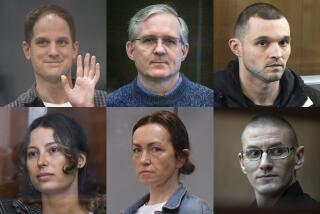U.S. Envoys Move to New Moscow Apartments With Pool, Bar--and Guards
- Share via
MOSCOW — Most of the U.S. diplomats here have moved into new, showplace quarters in a 10-acre compound surrounded by a wall of red brick imported from the American state of Georgia.
Their townhouses, with the same red-brick facades, contain such Moscow rarities as microwave ovens, all-electric heat and air conditioning.
Community facilities include a swimming pool, squash and handball courts, a basketball court, a supermarket-style commissary and an oak-paneled bar.
“You won’t see another building like it around Moscow that is as well-designed for living,” boasted U.S. Ambassador Arthur A. Hartman, who conducted a tour of the new area Monday for American correspondents.
But Hartman is not pleased by the Soviet decision to establish 24 police guard posts outside the brick wall, supposedly to guard the Americans against intruders.
“I complained and said it looks like Alcatraz,” he said. “I think there are too damned many of them, and it’s really stupid.”
Nearly all of the 134 apartments--from one-bedroom units to four-bedroom duplexes and a five-bedroom, eight-bathroom house for the deputy chief of mission--are now occupied. The embassy also rents apartments elsewhere in Moscow for about 50 diplomats who will remain outside the compound.
The compound’s amenities also include a heated underground garage for 130 cars, especially handy in a Moscow winter, and evergreen shrubbery with an automatic watering system.
Fit for Entertaining
Correspondents were shown a four-bedroom, three-floor apartment designed for “representational use,” which is State Department jargon for those diplomats with sufficient status that they would entertain Soviet guests.
Shirley Benson, who once lived in the old embassy compound, said she is delighted by her new quarters, adding: “This is more comfortable and more attractive. . . . The view on the courtyard (of the old embassy) got depressing after awhile.”
The red brick was imported from Georgia, Hartman explained, because it was just the right shade the architect wanted and because the Georgia firm was the lowest bidder on the project. Even counting the cost of shipping the bricks to Moscow, he said, the price was lower than that quoted by British firms.
One Soviet bricklayer, he recalled, arranged light and dark bricks to spell “USSR” in Cyrillic letters on the wall of one housing unit. When it was discovered, the Soviet symbol was removed.
The lineup of brick row houses, Hartman said, is a “little bit of Americana--although it does look like London.”
Hartman said he does not think the place is too plush in view of the hardships of living in Moscow. As for concerns about American diplomats becoming isolated in the compound, Hartman said they will continue to make contacts with Soviet citizens.
“What holds back Soviet contacts is the attitude of the Soviet government, which discourages (its citizens’) contacts not only with Americans but with all foreigners,” the ambassador said.
All-American Task
Because the Soviet Union this fall withdrew Soviet employees from the U.S. Embassy in retaliation for the expulsion of 55 Soviet diplomats from America, maintenance of the new compound will be an all-American task.
In the center of the compound is a red-brick white elephant--an eight-story chancery building that has been under construction for seven years and may not be occupied for another three years.
Security problems, particularly the need to ensure that the new embassy is free of Soviet eavesdropping devices, were reported to be one reason for the long delay. The slow pace of Soviet construction workers has also delayed completion.
Until the building is ready, American diplomats will continue to work in a battered old building about 500 yards away, where, Hartman complains, Soviet eavesdropping is “very bad.”
Soviets Also Delayed
In the new embassy, he said, the situation will be much better. Until the Americans move into their new chancery, the Soviet Union will not be able to occupy its new embassy building on a Washington, D.C., hilltop, the State Department has decreed.
The embassy and its housing area were originally scheduled to be completed by the end of 1983 for a cost originally estimated at $30 million. Now, however, the final price tag is expected to be $167 million, and the date of completion is still far in the future.
Hartman told reporters, however, that the office building, housing and facilities were built for far less than they would have cost anywhere in the United States, adding, “I am told by the experts it’s a damn good buy.”
American residents of the compound complained that Soviet police have been checking the documents of Soviet guests even when escorted by their hosts--a practice that is not customary among police posted at other buildings where foreigners live in Moscow.
This is a form of harassment intended to discourage Soviet visitors, U.S. diplomats said, adding that they have voiced objections and that such scrutiny of documents will be stopped soon.
More to Read
Sign up for Essential California
The most important California stories and recommendations in your inbox every morning.
You may occasionally receive promotional content from the Los Angeles Times.













